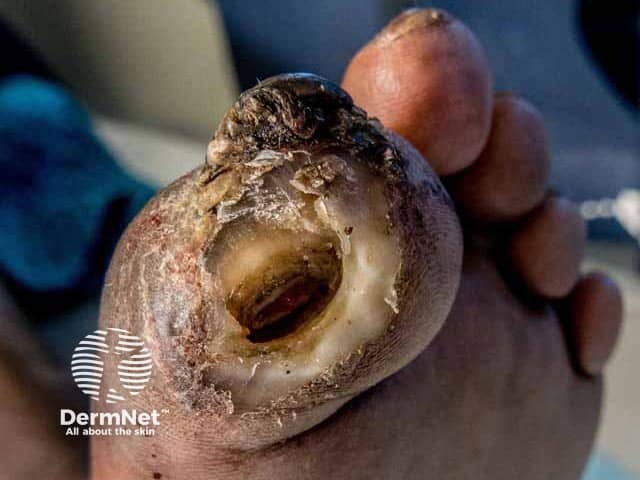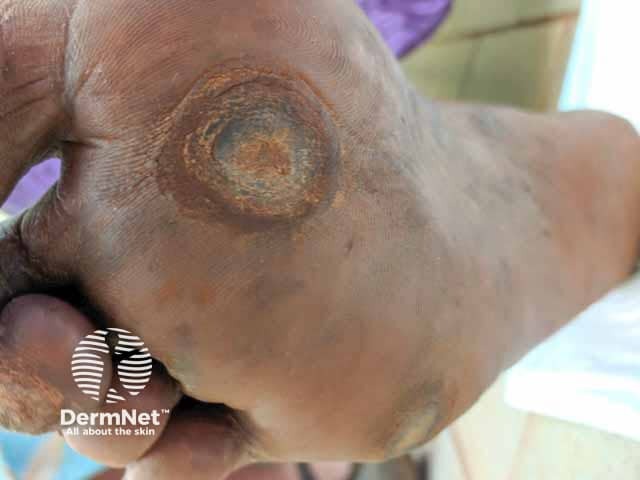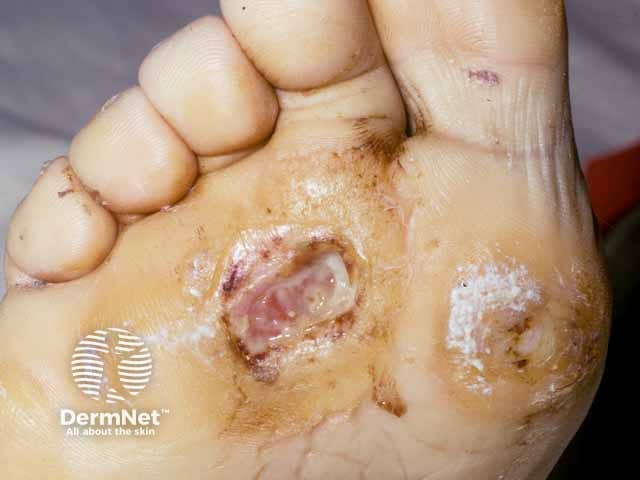Main menu
Common skin conditions

NEWS
Join DermNet PRO
Read more
Quick links
Authors: Vanessa Ngan, Staff Writer, 2003. Revised: Dr Sashika Samaranayaka, Post Graduate Year 1, Department of Dermatology, Middlemore Hospital Auckland, New Zealand; Hon Assoc Prof Paul Jarrett, Dermatologist, Clinical Head Dermatology, Middlemore Hospital and Department of Medicine, The University of Auckland, Auckland, New Zealand. Copy edited by Gus Mitchell. January 2021.
Introduction Demographics Causes Clinical features Complications Diagnosis Differential diagnoses Treatment Outcome
Diabetic foot ulcer is a skin sore with full thickness skin loss on the foot due to neuropathic and/or vascular complications in patients with type 1 or type 2 diabetes mellitus.
Diabetic foot ulcer has an annual incidence of 2–6% and affects up to 34% of diabetic patients during their lifetime. Risk factors for developing a diabetic foot ulcer include:
Diabetic foot ulcers are caused by neuropathic and/or vascular complications of diabetes mellitus.
High blood sugar levels can damage the sensory nerves resulting in a peripheral neuropathy, with altered or complete loss of sensation and an inability to feel pain. Peripheral neuropathy develops in approximately 50% of adults with diabetes, increasing the risk of injury to the feet from pressure, cuts, or bruises.
Blood vessels can also be damaged by long-standing high blood sugar levels, decreasing blood flow to the feet (ischaemia) and/or skin (microangiopathy). This can result in poor wound healing.
A diabetic foot ulcer is a skin sore with full thickness skin loss often preceded by a haemorrhagic subepidermal blister. The ulcer typically develops within a callosity on a pressure site, with a circular punched out appearance. It is often painless, leading to a delay in presentation to a health professional. Tissue around the ulcer may become black, and gangrene may develop. Pedal pulses may be absent and reduced sensation can be demonstrated.

Foot ulcer at a pressure site


The severity of a diabetic foot ulcer can be graded and staged. There are many different classification systems. The University of Texas (UT) classification is a widely used, validated system (Table 1).
UT Grade |
UT Stage |
0: Pre- or post-ulcerative or healed wound |
A: No infection or ischaemia |
1: Superficial wound not involving tendon, capsule, or bone |
B: Infection present |
2: Wound penetrating to tendon or capsule |
C: Ischaemia present |
3: Wound penetrating to bone or joint |
D: Infection and ischaemia present |

UT Grade 1

UT Grade 2

UT Grade 3
Diabetic foot ulcer is particularly prone to secondary infection resulting in:
Diabetic foot ulcer is a clinical diagnosis of a painless foot ulcer in a patient with a long history of poorly controlled diabetes mellitus.
Investigations may include:
Diabetic foot ulcer may:
The five-year mortality rate has been estimated to be 42%.